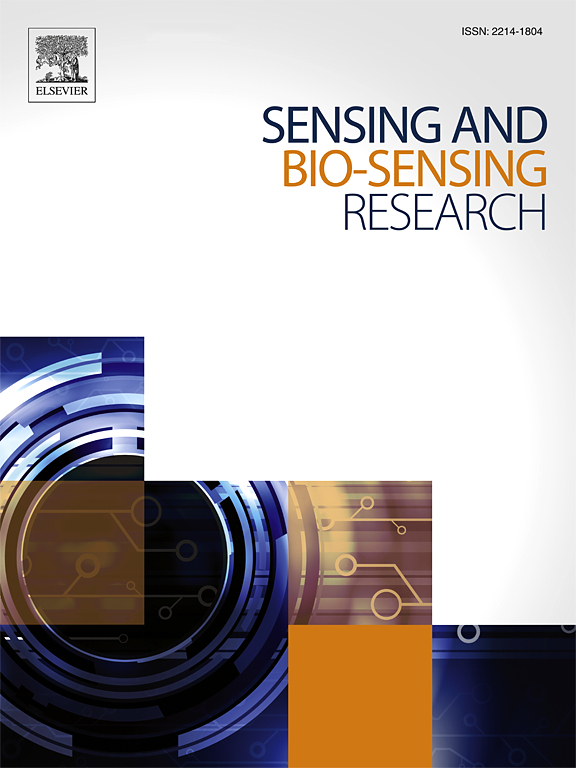Gold and titanium dioxide enhanced PCF SPR biosensor for early breast cancer detection in near infrared spectrum
IF 4.9
Q1 CHEMISTRY, ANALYTICAL
引用次数: 0
Abstract
Breast cancer is a major public health concern, with early detection significantly increasing the survival rate. This study focuses on the development of a photonic crystal fiber (PCF) based surface plasmon resonance (SPR) biosensor for detecting breast cancer cells, specifically MDA-MB-231 and MCF-7 cell lines. The proposed circular shaped biosensor is coated with gold (Au) and titanium dioxide (TiO2), where an Au layer is inserted over the fused SiO2. TiO2 is used as an adhesion layer which is covered by an analyte layer. There is a perfectly matched layer (PML) for absorbing scattered light from the internal structure. Using COMSOL Multiphysics, the biosensor's geometrical design was optimized, and finite element method (FEM) simulations were performed to evaluate its performance. The proposed biosensor operates within the refractive index (RI) range of 1.385 to 1.401, targeting breast cancer cell detection. Key performance metrics such as wavelength sensitivity (WS), amplitude sensitivity (AS), sensor resolution (SR), and figure of merit (FOM) were assessed. The proposed biosensor demonstrated the highest WS for MCF-7 of 29,285.17 nm/RIU in x polarization and 25,000 nm/RIU in y polarization. Similarly, the highest AS of 2136 in x polarization and 2975 in y polarization was achieved for MCF-7. The proposed biosensor showed exceptional FOM of 127.89 for MCF-7 in x polarization and 73.26 for MDA-MB-231 in y polarization. The proposed biosensor outperformed the existing literature. This biosensor offers significant potential for early stage breast cancer detection, contributing to more accurate and timely diagnoses, ultimately aiding in better treatment outcomes and patient survival.
金和二氧化钛增强PCF SPR生物传感器近红外光谱早期乳腺癌检测
乳腺癌是一个重大的公共卫生问题,早期发现可大大提高生存率。本研究的重点是开发一种基于光子晶体光纤(PCF)的表面等离子体共振(SPR)生物传感器,用于检测乳腺癌细胞,特别是MDA-MB-231和MCF-7细胞系。所提出的圆形生物传感器涂有金(Au)和二氧化钛(TiO2),其中金层插入在熔融的SiO2上。TiO2被用作附着层,被分析物层覆盖。有一个完美匹配层(PML),用于吸收来自内部结构的散射光。利用COMSOL Multiphysics软件对生物传感器的几何设计进行了优化,并对其性能进行了有限元仿真。该生物传感器工作在1.385 ~ 1.401的折射率范围内,用于乳腺癌细胞检测。评估了关键性能指标,如波长灵敏度(WS)、幅度灵敏度(as)、传感器分辨率(SR)和品质系数(FOM)。MCF-7在x极化和y极化下的WS分别为29,285.17 nm/RIU和25,000 nm/RIU。同样,MCF-7在x极化和y极化分别达到了2136 RIU−1和2975 RIU−1的最高能谱。所提出的生物传感器在x极化下MCF-7的FOM为127.89 RIU−1,在y极化下MDA-MB-231的FOM为73.26 RIU−1。所提出的生物传感器优于现有文献。这种生物传感器为早期乳腺癌检测提供了巨大的潜力,有助于更准确和及时的诊断,最终有助于更好的治疗结果和患者生存率。
本文章由计算机程序翻译,如有差异,请以英文原文为准。
求助全文
约1分钟内获得全文
求助全文
来源期刊

Sensing and Bio-Sensing Research
Engineering-Electrical and Electronic Engineering
CiteScore
10.70
自引率
3.80%
发文量
68
审稿时长
87 days
期刊介绍:
Sensing and Bio-Sensing Research is an open access journal dedicated to the research, design, development, and application of bio-sensing and sensing technologies. The editors will accept research papers, reviews, field trials, and validation studies that are of significant relevance. These submissions should describe new concepts, enhance understanding of the field, or offer insights into the practical application, manufacturing, and commercialization of bio-sensing and sensing technologies.
The journal covers a wide range of topics, including sensing principles and mechanisms, new materials development for transducers and recognition components, fabrication technology, and various types of sensors such as optical, electrochemical, mass-sensitive, gas, biosensors, and more. It also includes environmental, process control, and biomedical applications, signal processing, chemometrics, optoelectronic, mechanical, thermal, and magnetic sensors, as well as interface electronics. Additionally, it covers sensor systems and applications, µTAS (Micro Total Analysis Systems), development of solid-state devices for transducing physical signals, and analytical devices incorporating biological materials.
 求助内容:
求助内容: 应助结果提醒方式:
应助结果提醒方式:


